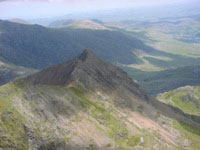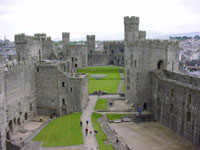![]()
| Britain | Wales | 2000.06.06 - 06.11 |
Note: Britain consists of England/Wales/Scotland and The United Kingdom consists of England/Wales/Scotland/Northern Ireland.
Is Wales part of England? This is the question we had when we found out that Wales 1) doesn't have its own governing body 2) uses English pounds as their currency and 3) was conquered by England during the rule of King Edward I in the late 13th century. We got mixed answers to this question, but many people said, "That's a difficult one". The Welsh culture and language are definitely different than the English. As our Welsh B&B host stated, "We like others to know that we're different". In some parts of Wales, people learn Welsh as their first language and English as their second. We stayed with such a family at a B&B in a tiny town called Capel Garmon near the larger town of Betws-Y-Coed in the region of Snowdonia. The children's school teaches all subjects in Welsh. English is a second language that is taught from age 6. At age 11, the child must decide whether to continue his/her education in Welsh or English.
As we drove into Wales, the first thing we noticed was the strange spelling of place names on the road map - places like Aberystwyth and Tywyn and Llansantffraed Cwmdeuddwr. As Masami navigated and I drove, she said, "OK. Now you need to drive north on A470 towards el-il-wuh-cc... I can't say this word!". Then she guessed that the cartographer must have misplaced his hands on the keyboard and typed away without noticing.
Capel Garmon is a farming village. The people work hard to survive. Although the standard of living is high, they feel economic pressure imposed by the wealthy English who buy small summer homes in Wales. These homes would normally be a young couples' first house where they could begin to build equity and become financially stable. With the influx of English buying, starter homes are scarce and prices are inflated. This is a major concern of some of the Welsh in Wales.
We spent a week in Wales and were overwhelmed by the Welsh hospitality and genuine friendliness. In the end, we decided that since Wales is part of Britain and England is part of Britain, we should put the question about Wales being part of England to rest. My next question is, "If England is part of Britain and Scotland is part of Britain, then why do both send soccer teams to the European tournaments?" Seems like if Britain can send multiple teams, Germany, France, and the others should be allowed to as well.
The Brecon Beacons, Wales
Our first stop in Wales was a south central hilly area called Brecon Beacons. Someone in London recommended the area for hiking, so we went. We stopped by the National Park Visitors Centre in the city of Brecon where a ranger recommended a trail to the peak and advised that we carry a map. She sold us a completely useless map for £3.95 that we later realized was entirely unnecessary after seeing the well-worn track from base to peak. The hike was a pretty day stroll. The map claimed the distance to be 9 miles. We thought it was shorter. The highest peak called Pen Y Fan stood at 2907 feet / 886 meters. The grazing sheep were cute, and we got our fill of fresh air, but don't expect much else.
Brecon Beacon helpful hiking information:
|
|
Wes looks into the valley from the trail to Pen Y Fan. The trail is clearly visible around the entire mountain ridge making a map unnecessary. |
|
|
Sheep-lamb pairs speckle the hillside. The lack of trees on the hills is due to the sheep's constant nibbling of the vegetation. |
|
|
We made it to the peak along with the other 1000 tourists and school children. Hey, repositioning our photo angle makes the peak appear deserted. How deceptive pictures can be! |
Snowdonia, Wales
The main attraction of Snowdonia region is hiking and the mountains. Tim from Manchester, England who we met while hiking in Mulu, Sarawak, Malaysia recommended Snowdonia as "the best hiking in the United Kingdom", and wow is it pretty. We decided to hike to the top of the highest peak: Snowdon in English and Yr Wyddfa in Welsh (don't ask me to pronounce it) standing at 3559 feet / 1085 meters. The day we hiked was windy and cold. Masami and I had on our pile pull over and winter jacket with hood pulled over our head, and we were still cold. The only drawback for hikers walking Snowdon is the train that carries hoards of tourists to the top from the town of Llanberis.
Snowdon helpful hiking information:
 |
The Snowdon mountain ridge rises above the Pyg Trail that most hikers follow to the peak from Pen Y Pass trailhead. The more adventurous can climb a steep cliff to the ridge and hike along it to the peak. |
 |
After a hike up the Pyg Trail, Wes decided to take the ridge back. The trail often disappeared and strong gusts of wind tried to knock Wes off. Fortunately, Wes teamed up with Welshman Nick (pictured) to figure out the way down. Masami (the smart one) descended via the Pyg Trail.. |
The Castles of Wales
There are two types of Castles
in Wales: those built by the Welsh to protect themselves from English
invasion and those built by the English to complete the conquering of
Wales. Many of the best preserved castles are English built by King Edward
I in the late 1200s. It's easy to tell them apart. A Welsh castle is a
single structure. Penetrating a single Welsh castle wall equals defeat of
the castle. King Edward I studied castle defense throughout Europe and
constructed his castles with inner and outer fortifications. The outer
castle housed the soldiers and contained most of the defensive force. The
king and other important people resided in the inner castle complete with
draw Caernarfon Castle in the city of Caernarfon was built by King Edward I in 1283 as a
fortress and palace. Decent tour guides can bring the castle back to
life with their stories, explanations of the purpose of each room, and
description of the structures before they fell into ruin. bridge,
high walls, and defensive structures in case of an outer
castle wall penetration. The double obstacle of the inner/outer castle
design gave the king enough time to escape if faced with an overpowering
attacking force.
bridge,
high walls, and defensive structures in case of an outer
castle wall penetration. The double obstacle of the inner/outer castle
design gave the king enough time to escape if faced with an overpowering
attacking force.
Copyright © 2000-2002 Wes and Masami Heiser. All rights reserved.